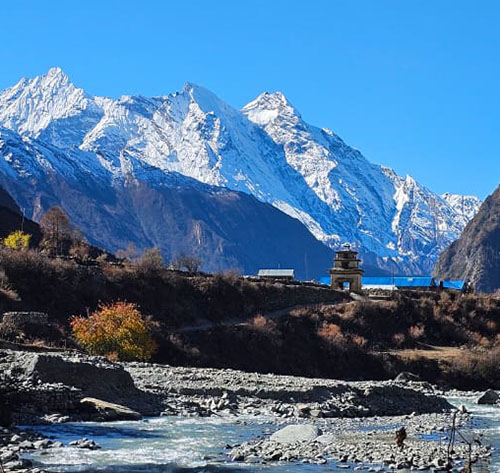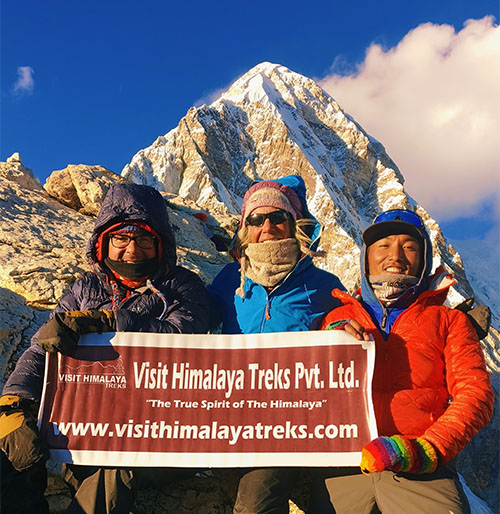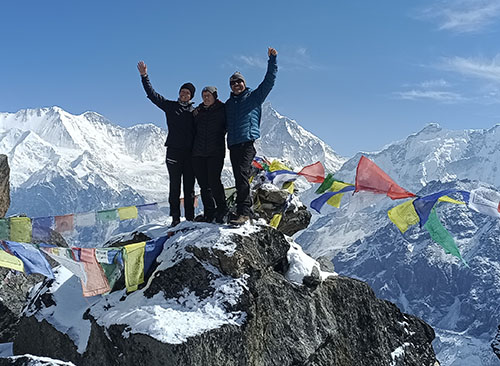Kanchenjunga is the world’s 3rd highest peak and 2nd tallest in the Nepal Himalayas. Mt. Kanchenjunga straddles the border between Nepal and Sikkim, a small North-East State of India. Kanchenjunga the exact pronunciation is Kanchendzonga, which means a mountain with five jewels referring to its 5 adjoining peaks.
One of the longer adventurous walks around the Himalayas takes more than three weeks. However, for the last few years, the itinerary has been shortened to a few days. Due to the construction of a motorable dirt road, which is not gravel or pitched.
Kanchenjunga Trekking is the only trek in all the Himalayas that reaches both the North and South Base Camps of Mount Kangchenjunga. Located in Nepal Far East in the district of Taplejung, a mid-hill farm country with many nice villages.
Taplejung has a small airport at Suketar, which can make the trek much shorter. But the flight to and from Kathmandu is irregular, unreliable, and unpredictable, due to Himalayan weather conditions. As well as a lack of passengers and the cost of flying to Suketar, which is doubtful even in the best seasons of the year.
That is why most locals and trekking agencies do not include flights to Suketar, which can lead to delays. It gets postponed or canceled in the last hour. The best way is to fly from Kathmandu to Bhadrapur airport, located in Nepal's Far Eastern low-land of the Terai belt. A scenic flight in a bigger aircraft of 40 to 45 minutes with awesome views of the Himalayan range.
From Jugal, Everest, Lhotse, Makalu, and Kanchenjunga massif, from Bhadrapur overland journey leads us to the trekking starting destination. The best for a rough hill road taking a few days drives to reach the starting point of trekking. As well as on the same route back after completing the marvelous experience on Kanchenjunga base camp trekking.

Our Team at Drohmo Ri View Point, Kanchenjunga North view background.
Trekking Trails and Road connectivity On the South Side of KBC.
Possible to drive as far as along the way to Yamphudin Kanchenjunga South Base Camp side of Taplejung. About 4 days of trekking from Taplejung or Suketar, the original Kanchenjunga Base Camp Trek starting Point.
Nowadays It is possible to drive as far as Yamphudin South side of Kanchenjunga which is about 4 days of trekking from Taplejung. Note that the road is a newly open track which is only accessible during the dry season. So Starting your Kanchenjunga Trekking month in September may not allow you to drive along the Yamphudin because of a landslide and bridge in the stream.
Reaching Yamphudin or further up to Sherpaguan, you will connect with the regular Kanchenjunga Base Camp Trekking trail and start your real trekking journey. From Sherpa Gaon towards Lasiya Bhanjyang then to Tortong, Tseram, and Ramche. Ramche is the last stopping point for trekking groups and it's known as Kanchenjunga South Base Camp.
Trekking Trails and Road connectivity On the North Side of KBC.
Nowadays it is possible to drive to Ranipul (Also known as Hellok) Kanchenjunga North Base Camp side. Which is about 3 days of Trekking from Taplejung which is the Original route of Kanchenjunga North base camp Route. Note that It may not be accessible around the year, like during the monsoon time often this temporary road can be blocked by landslides and big flows of water.
From Ranipul our real Kanchenjunga North base camp hike starts following the regular KBC trekking trail. On route to Kanchenjunga North Base Camp, we will trek following the regular trail via Sekathum, Amjilosa, Thyanyan, Gyabla, Phale, Ghunsa, Kambachen, Lhonak and Pangpema. Pang Pema is known as Kanchenjunga North base camp located elevation of 5143 meters.

Best Availability Accommodation In the Kanchenjunga Region of Nepal.
Standard of Tea-House / Lodge availability:
At present, both sides of Kanchenjunga en route to North and South Base Camps, Tea-House and Lodges are available. But most lodges or tea houses en route on either side are small and simple with basic facilities. Trekkers have to suffice in whatever the Tea House or Lodge provides from simple rooms and foods.
In the early days just a decade ago, full camping equipment and food had to be carried for the whole treks. At present, trekkers can spend overnights in a simple room, lodges en route do not have attached baths and toilets. Major villages have small hydropower to run electricity, mainly to light the dining room. In higher and remote isolated areas, the lodge provides electricity run by solar power. Important to know using hot showers from the lodge, at extra cost as well for charging electronic items. Trekkers need to carry strong flash/torch lights, as some lodges will have dim lights depending on the weather.
For less than ten people lodges can accommodate depending upon the influx of trekkers in high seasons. If the group size of more than 10 people, the best is camping. The company booked with will do all the logistic support required for tented camping.
Tea House or Camping Trek to Kanchenjunga?
Trekking in groups of above 10 people, the company will organize the treks on a camping basis. Which is the best and classic way of trekking in the Himalayas like in the early days. The camping equipment will be carried throughout the treks, supported by a separate unit kitchen department.
Includes cook, kitchen staff, guide, and porters or pack animals sometimes to carry the camping gear, food, and baggage. The camping includes two men's tents, for a single supplement on request at extra cost. Dining tent as per the size of a group, kitchen, and toilet tent with dug-out deep hole. All food in camping is cooked in kerosene or LPG Gas stove, using no firewood. We Visit Himalaya is committed to eco Trekking and Responsible Tourism and follows the norms in all treks and other adventures.

Visit Himalaya Treks Campsite at Tseram, Kanchenjunga South Side.
Availability of Food on Kanchenjunga Trekking:
On leaving towns and main villages, like Suketar, only simple food is available en route to North, and South Kanchenjunga Base Camps. Due to its remote location and far from the nearest road-head, where all provisions need to be carried. The other main reason is less flow of foreign visitors than other mainstream trekking regions.
Around small isolated villagers store limited varieties of foods only for their own, expecting only a few visitors. Trekkers need to understand before booking or venturing into remote corners of the Himalayas like around Kanchenjunga Trekking. Most lodges can offer only simple meals to their guest, where the food menu of less variation.
Trekkers have to suffice with whatever is available, the most common foods for main course meals. The famous and national food of the country is Dal Bhat (boiled or steamed rice and lentil soup of different colors and species. Served with seasonal vegetable mild curry, and home-made pickles.
The other main course meal is chapatti an unleavened dry or buttered wheat bread. Dhedo is a favorite among mountain and hill people, a porridge cooked with grains of wheat, barley, buckwheat, millet, or corn flour. Includes mild soup and homemade sauce and vegetables.
The other available foods are noodles either with soup or fried with veg or eggs. Mo-Mo is a dumpling stuffed with vegetables, potatoes, carrots, cabbage, or spinach. Soups are available from dry vegetables which are popular as a national food item called Ghundruk.
In Kathmandu, restaurants it is named as Himalayan soup on the menu. Tea, Coffee, or cold drinks are available as well as local yogurt and curd. To keep your daily diet and nutrition balanced for the treks, Like, biscuits, cookies, nuts, chocolate, muesli, and corn-flakes, are available in most of the Tea Houses.
Best availability Tea House in the Kanchenjunga Region of Nepal.
Ghunsa is one of the lovely mountain villages populated by Sherpa people. The indigenous Himalayan tribes of strong Tibetan influence and origin. The houses are built of stones and fine woods having wide and well-kept farms, growing buckwheat and barley. Including seasonal vegetables and crops, a great place to enjoy the comfort of a nice lodge accommodation. In the harmony of traditional hospitality of the Ghunsa natives, serving good foods of great choices than other simple lodges. The lodges at Ghunsa also provides hot shower along with the best food menu to enjoy.
Trekkers after days of walking up and down enjoying the dramatic landscape scenery of stunning snow-capped peaks. After a great experience walking either from other South Base Camp routes or heading straight to Kanchenjunga North Base Camp. Spending overnights in a simple basic lodge with a limited food menu on reaching Ghunsa will be a surprise. On finding one of the best tourist standard lodges or Tea House in Ghunsa at 3,480 m high. The lodge accommodation is much larger with neatly kept rooms. As well as lively and cozy dining with more items on the food menu to enjoy overnights in Ghunsa.

Ghunsa Village and Kanchenjunga Guest House, the best available Guest House Kanchenjunga Region of Nepal.
Required duration for Kanchenjunga Trekking:
It is possible to cover the whole Kanchenjunga circuit by visiting both South and North Kanchenjunga Base Camps. In the early days ten years before it was not possible less than 4 weeks, at present for 3-4 years, the motorable road has reached. Around the mid-hills beyond Taplejung Town and far as Yamphudin on the South side and Ranipul (Hellok) on the North side that making it accessible to complete the whole trek in a much shorter time. Like 21 to 23 days is a perfect duration for this wonderful adventure with drives and flights both ways.
Interested people, can extend the trek for a few days more, to enjoy a walk within Kanchenjunga’s beautiful scenery and pristine wilderness. Some itinerary days are 21 to 23 days, but 26 days of Kanchenjunga Base Camp Trek is the average and standard itinerary day. If the small airport of Suketar, Taplejung were active and busy like Lukla in the Everest region. It would have been possible to complete the whole journey in less than three weeks, hope it happens shortly in the near future.
Sinion-La Pass, Mirgin-La Pass, Sele-La Pass, and Pass connect Kanchenjunga South and North Base Camp.
Start the morning walk to a place called Yalungbar. The trail leads to a steep climb, crossing the river and then entering into a dense forest. The walk follows an uphill path for an hour to reach close to a small pond. From here heading up across three smaller passes Sinion-La Pass 4646 meters, Mirginla PAss 4480 and Sele La Pass 4250 meters.
Traverse over Sele-La at 4,250 m high, enjoying the super panorama of Makalu, Baruntse, and Chamlang Himal. From the last pass of Sele-La, downhill to the base of the pass for an overnight stop, after a long day treks.
Alternative Route that connects Kanchenjunga South and North Base Camp.
The alternative route leads along the Simbuwa Khola via Yasan from the Tortong that connects KBC south side to the North Side. Similarly from Ranipul (Hellok) via Yasan, it is connected to Kanchenjunga North to South Base camp. Covering the deep snow and track is not open due to deep snow over the pass Sinion-La Pass (4,646 m) Mirgin-La Pass 4480 m Sele-La Pass (4,250 m) is it still possible to trek both sides of Kanchenjunga following the alternative trekking route as this blog mentioned here. If you are still confused please contact us for more details.

Janu Himal View, On the way from Janu Himal Base Camp.
Why Kanchenjunga Base Camp Trek is a real unique unspoiled Trekking Destination in Nepal?
Mt. Kanchenjunga at 8,586 m / 28, 169 feet, stands as the world’s 2nd highest peak and 2nd tallest in Nepal. An exciting and enjoyable walk on the hidden corners of far eastern Nepal, one of the unique, unspoiled, and undisturbed. Due to its remote location, and least accessibility with less number of visitors than other popular trekking destinations. Makes, Kanchenjunga so special and exceptional to enjoy the perfect harmony of serene mountain wilderness.
The walking trails amidst a tranquil environment, heading past from one lovely farm village to another, then entering dense woodland. The forest is lined with tall trees of rhododendrons, pines, firs, and oaks, and then reaches the wide glacial valley. A perfect choice to enjoy the thrills within pure natural wilderness away from the maddening crowd of modern civilization. Truly a great scenic adventure of a lifetime experience trekking around both sides of beautiful areas of Kanchenjunga.
Kanchenjunga's Trekking recent update conclusion.
The Kanchenjunga Trekking is a long walk covering a distance of approx. 220 km / 137 miles. This leads to quite strenuous walks of steep ups and downhill’s require good physical fitness with sound health. To cover almost three weeks of sustained walking, a real thrill of a challenge. To reach both sides of Kanchenjunga South and North Base Camps in one single journey.
Nevertheless, it is the most exciting country walk around the Eastern Himalayas encountering less numbers of trekkers. Where you will be in a world of your own in complete tranquility amidst sheer mountain wilderness. It is worth a lifetime experience, although the lodge facilities are not up to the standard. But it is very different and unique than any other adventure destination around the whole Himalayas. As well as several of transportation to enjoy from scenic flights to exciting and interesting drives on the mountainous trails.










